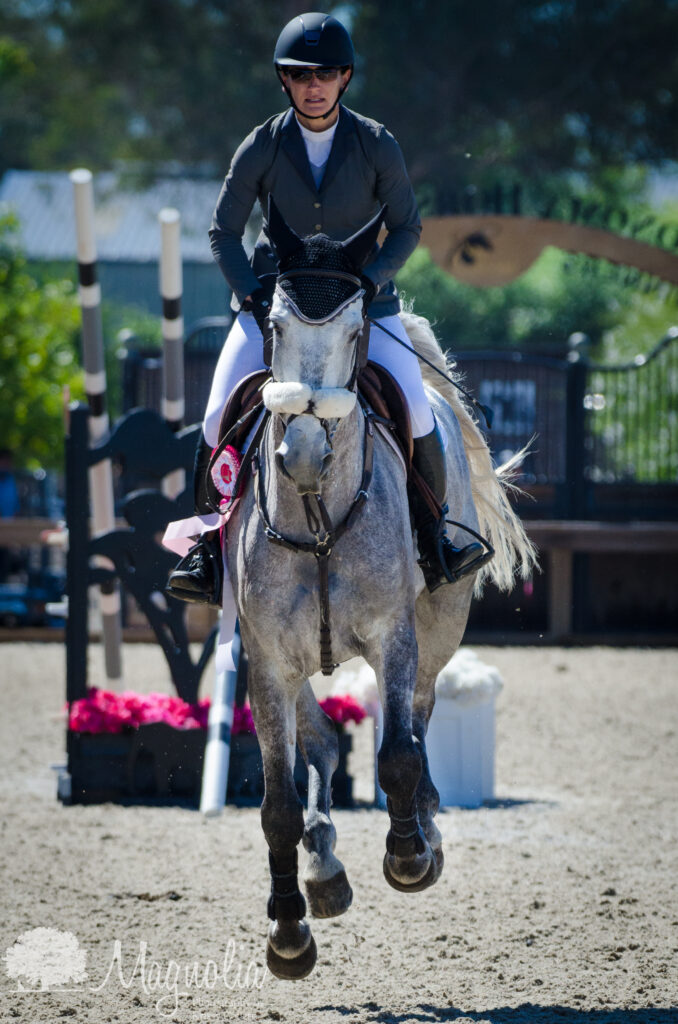Tag: puchalski
A Look at Palm Beach Equine Clinic’s Advanced Imaging Technology
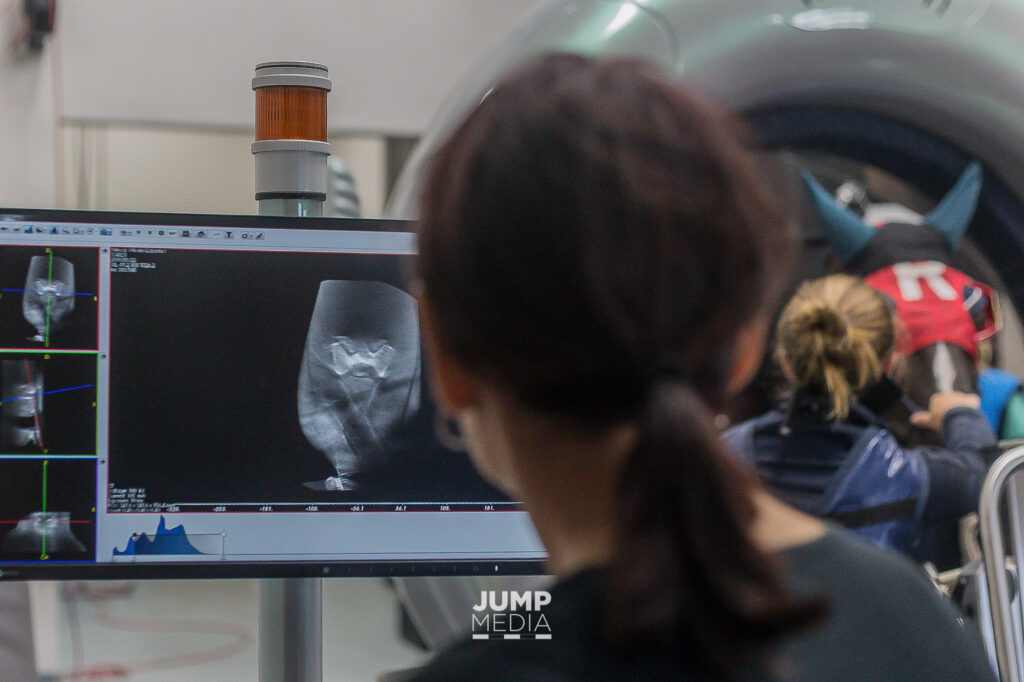
Photo by Jump Media
Palm Beach Equine Clinic takes pride in being a world-class facility for the diagnosis, treatment, and recovery of some of the industry’s most valued sport horses, as well as backyard companions. A vital area of the Equine Hospital that helps veterinarians to diagnose subtle or acute lameness is the Advanced Imaging Department.
Producing thousands of scans a year across all modalities, the Palm Beach Equine Clinic Imaging Department offers an on-staff, board-certified radiologist, and equipment that elevates the effectiveness of lameness diagnostics. Lameness is no longer a guessing game as PBEC veterinarians have an arsenal of imaging technologies to capture inside the horse.
Tour the PBEC Imaging Department:

Nuclear Scintigraphy (Bone Scan)
Nuclear scintigraphy begins with the injection of a radioactive isotope called Technetium 99 that is bound to a phosphate analogue. The isotope – phosphate molecule attaches to the mineral matrix of the bone in areas where bone is active. A gamma camera is then used to capture images of the skeletal anatomy. Points that “light up” on the image indicate increased metabolic activity as a possible site of injury.

Standing Magnetic Resonance Imaging (MRI)
The standing MRI produces highly detailed, cross-sectional images of bone and soft tissue in multiple different planes to fully image a desired region. The standing MRI requires sedation (not anesthesia) and is best used to further define a specific area that has already been pinpointed as the origin of lameness.
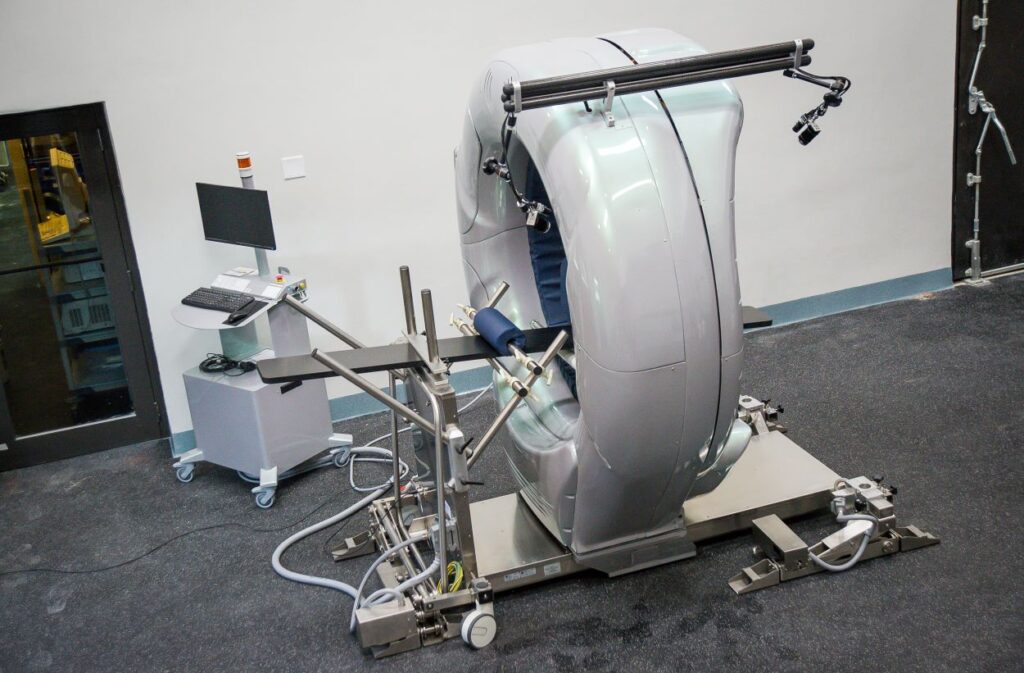
Computed Tomography (CT)
Similar to its use in humans, CT allows veterinarians the unique opportunity to conveniently explore areas of a horse’s body that were previously inaccessible. The machine produces 360 degree images of a horse’s neck, spine, and head and can be conducted while a horse is standing and under only light sedation.
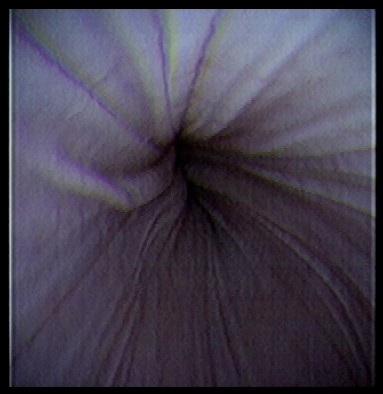
Endoscopy
An endoscope is an instrument that allows veterinarians to look inside the body by being inserted through a natural opening or incision. A tiny camera on the instrument allows an in-depth view of internal structures such as the upper and lower respiratory track, gastrointestinal and urinary tracts, as well as the cervix and uterus of mares.

Digital Radiography
Used routinely, radiographs are traditional x-rays that are made available within seconds for digital viewing and evaluation.
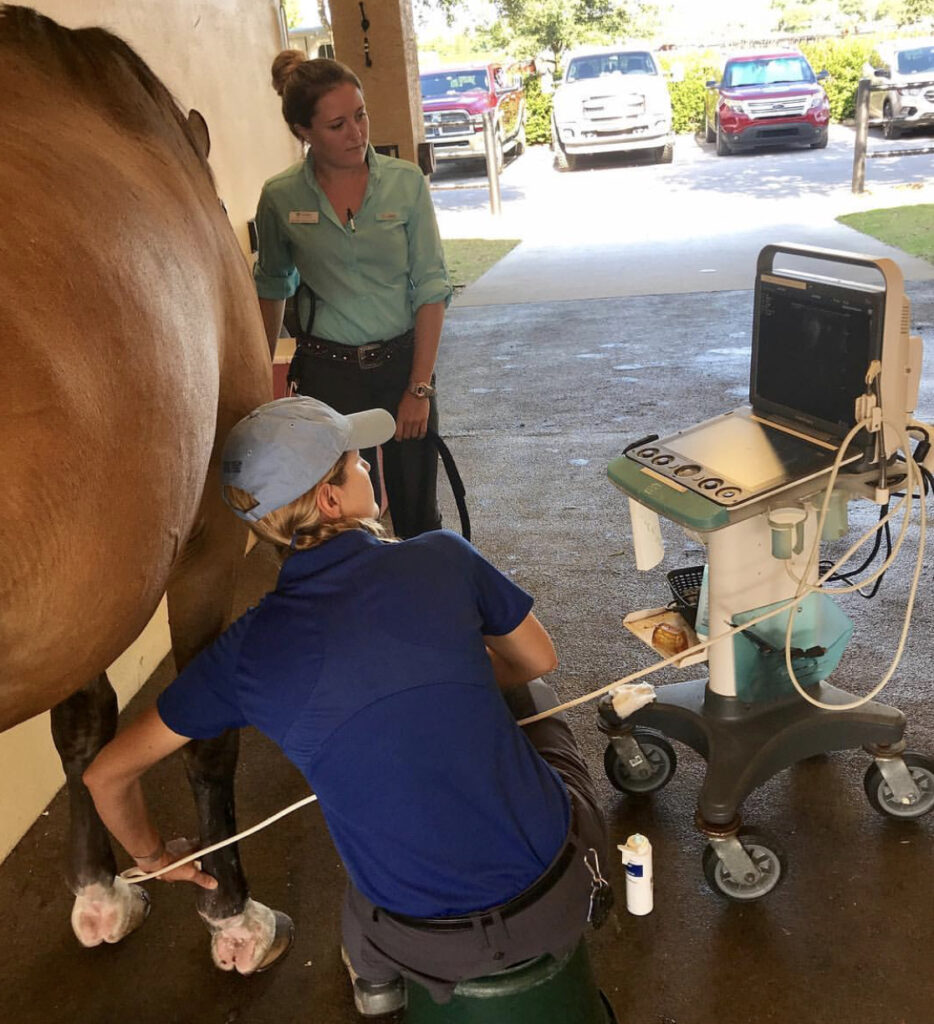
Ultrasonography
An ultrasound machine generates high-frequency sound waves, which echo an image back to the machine where bone appears white, fluid appears black, and all other structures are on a grayscale. An ultrasound is non-invasive, usually does not require sedation, does not use radiation or require injecting radioactive isotopes, and provides real-time images.
“These tools can give a definitive diagnosis, and that saves time and money in the long run,” said board-certified radiologist Dr. Sarah Puchalski. “For example, if a horse goes lame and it gets seen and treated empirically, which is a diagnosis based on likely problems through common diagnostic procedures, it either stays sound or it becomes lame again or even non-functional in three to six months. This method sets back the commencement of the appropriate therapy.
“What these modalities do is allow the horse to be treated early and correctly,” continued Dr. Puchalski. “Otherwise, you may not be treating the correct issue, and the horse could end up lame again very soon.”
Brittany Riddle, manager of PBEC’s Nuclear Scintigraphy Department, is fascinated by the structure of the horse’s body and helps to produce hundreds of bone scans per year.
“I’ve always had a strong interest in the anatomy of horses,” said Riddle, who spends her workday keeping patients comfortable and calm while operating a gamma ray camera housed in its own suite at Palm Beach Equine Clinic. “The horses are under light sedation for standing scans and these usually take from one to four hours depending on the type of scan. Usually during the winter competition season, we have anywhere from two to three horses being scanned daily.
“The variety of patients we treat is always interesting,” continued Riddle. “We see patients from all aspects of the industry. From racehorses to polo ponies, western performance, dressage, top show jumpers and hunters.”
According to Palm Beach Equine Clinic President Dr. Scott Swerdlin, having the latest in diagnostic capabilities drives the success of the Clinic.
“Many years ago, we committed to establishing Palm Beach Equine Clinic as an all-inclusive hospital and making it the most advanced referral center in the country,” said Dr. Swerdlin. “By investing in the very best personnel and equipment, we are able to provide the very best care we can for our patients.”
Palm Beach Equine Clinic board-certified radiologist Dr. Sarah Puchalski was featured in A Guide to Equine Diagnostic Imaging in the February 2020 issue of The Horse.
Learn more about equine diagnostic imaging by visiting our advanced diagnostic imaging page.
Palm Beach Equine Clinic in Wellington, FL, has state-of-the-art surgical and advanced diagnostic imaging equipment available. With board-certified Radiologist Dr. Sarah Puchalski, Palm Beach Equine Clinic uses the Equine Standing Magnetic Resonance Imaging (MRI) and a Nuclear Scintigraphy (bone scan) camera to quickly and accurately diagnose injuries for their clients.
Every horse owner dreads seeing signs of lameness or discomfort in any horse, whether it is a backyard companion or a top-caliber sport horse. For performance horses, however, one of the first questions many owners ask upon contacting a veterinarian about a problem is, ‘Can the horse safely and comfortably return to work?’ Using Palm Beach Equine Clinic’s cutting-edge technology, Dr. Puchalski can quickly and accurately answer that question.
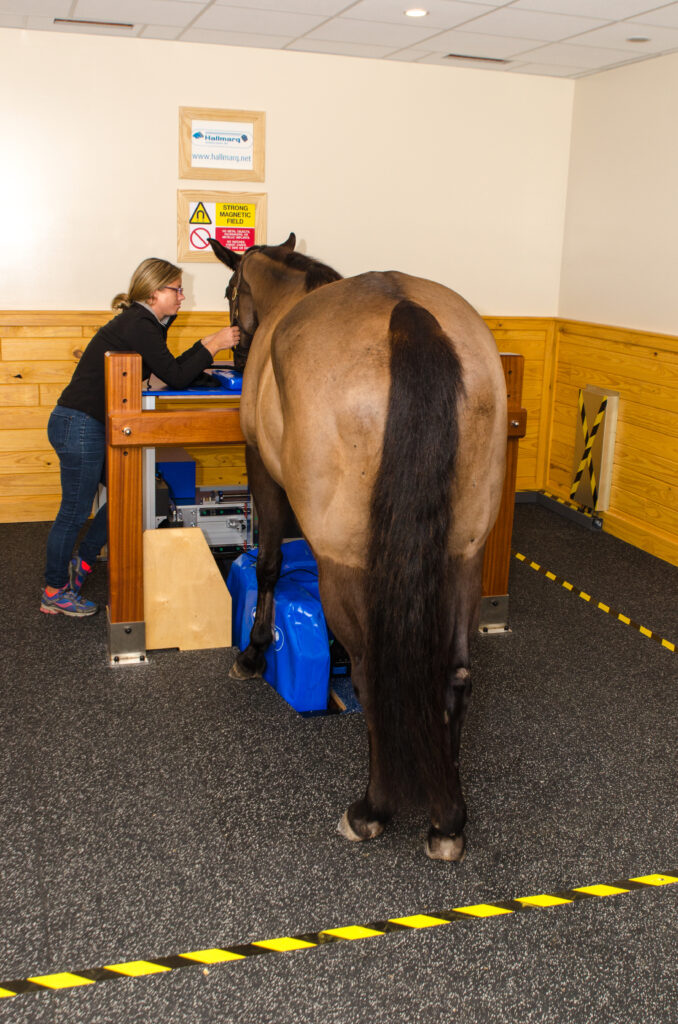
The Equine Standing MRI produces highly detailed images in several different planes to capture a complete image of a desired area. An MRI is best used to further define a specific area of both bony or soft tissue that has been pinpointed as the origin of lameness. The process can be completed while the horse is in a standing position and requires only light sedation.
Similarly, the process of Nuclear Scintigraphy (bone scan) begins with the injection of a radioactive isotope, specifically named Technetium 99. The isotope attaches to the phosphorous proteins localized within the bone and is absorbed over a few hours’ time. A specialized nuclear isotope gamma ray camera is used to capture images of the skeletal anatomy with a 360-degree view. Points of interest “light up” on the image to indicate increased metabolic activity and the site of injury.
Lameness or performance problems are most frequently approached through routine x-rays and ultrasounds, which can appear normal. Thus, it is difficult to diagnose subtle problems because the most common tools are not sensitive enough to diagnose in every case. At PBEC, the Equine Standing MRI and Nuclear Scintigraphy equip veterinarians with an advantage when troubleshooting a lameness issue and helps them to determine a correct, quick diagnosis.
Coupled with advanced technology, Palm Beach Equine Clinic is also one of very few equine practices in the U.S. with a Board Certified Radiologist on staff, and thanks to Dr. Puchalski, hundreds of MRI and bone scans are read each year at Palm Beach Eqine Clinic. In addition to state-of-the art diagnostic tools, the technology also affords economic benefits to owners.
“MRIs can give a definitive diagnosis, and that saves time and money in the long run,” said Dr. Puchalski. “For example, if a horse goes lame and is examined and treated empirically, which is a diagnosis based on likely problems through common diagnostic procedures, it either stays sound or it becomes lame again or even non-functional in three to six months. This method sets back the commencement of the appropriate therapy.
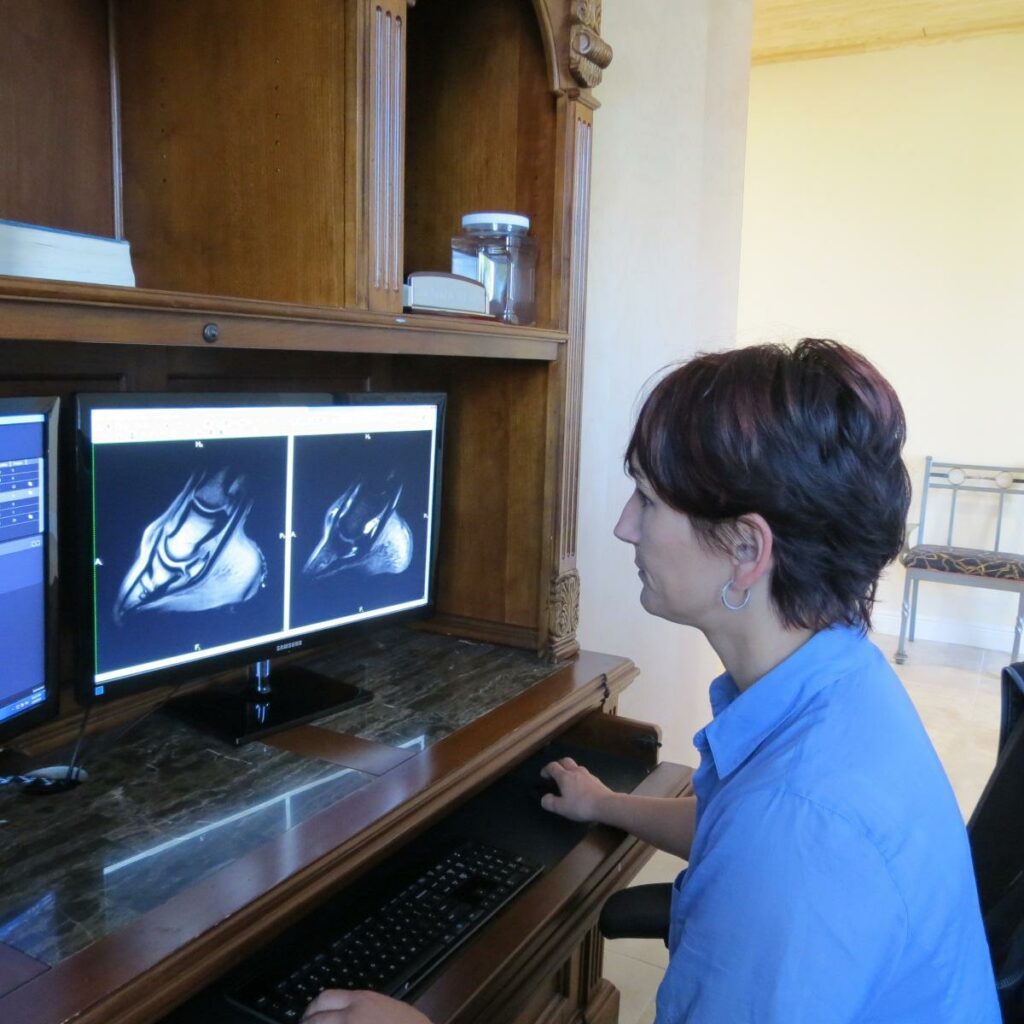
“What the MRI does is allow the horse to be treated early and correctly,” continued Dr. Puchalski. “Otherwise, you may not be treating the correct issue, and the horse could end up lame again very soon.”
Nuclear Scintigraphy does not produce a scan that is as specific, but it gives Dr. Puchalski the opportunity to procure a concrete quick diagnosis, as well as evaluate the whole horse for secondary problems.
“Oftentimes the primary problem in one place is making a horse sore in other places,” she said. “Owners like to know the root problem, but to also quickly diagnose secondary problems so the entire horse can be treated at once.”
As the official veterinary hospital of the Winter Equestrian Festival (WEF) and the Adequan® Global Dressage Festival (AGDF), Palm Beach Equine Clinic sees a high concentration of sport horses in need of care. In turn, owners of those horses are eager to see their horses quickly and happily return to competition.
“The biggest benefit to Palm Beach Equine Clinic and the Wellington community as a result of these MRI and Nuclear Scintigraphy scans is accessibility,” concluded Puchalski. “Anyone can call from the horse show to the clinic, get a scan scheduled quickly- in and out, get results fast, and then their training program can be changed immediately.”
About Dr. Sarah Puchalski
Dr. Sarah Puchalski is from Davis, CA, where she was an associate professor at the University of California in their Department of Surgical and Radiological Sciences. In 1995, she received her BS in biology from Simon Fraser University in British Columbia, and in 1999 earned her Doctor of Veterinary Medicine from the University of Saskatchewan in Saskatoon, where she received the ACVS Outstanding Large Animal Surgery Student award that same year. Dr. Puchalski interned in Field Service and Sports Medicine at New Bolton Center at the University of Pennsylvania in 2001, and completed her residency in radiology at UC Davis in 2005.
Dr. Puchalski has devoted her career to teaching and improving equine health through the development and refinement of diagnostic techniques. In 2011, she contributed to two books on the topic of equine lameness. Her recent contributions include chapters in “Diagnosis and Management of Lameness in the Horse,” edited by Ross and Dyson, as well as in “Veterinary Computed Tomography and the Clinical Veterinary Advisor: The Horse, Equine Colic and Veterinary Clinics of North America.” She also has contributed close to 50 scientific articles concerning the diagnosis of equine lameness to many periodic journals, including Veterinary Radiology & Ultrasound: the official journal of the American College of Veterinary Radiology and the International Veterinary Radiology Association; Veterinary Pathology; Equine Veterinary Journal; the American Journal of Veterinary Research; Equine Veterinary Education; Journal of the American Veterinary Medical Association; and Journal of Veterinary Internal Medicine.
Palm Beach Equine Clinic provides experience, knowledge, availability, and the very best care for its clients. Make Palm Beach Equine Clinic a part of your team!
Palm Beach Equine Clinic (PBEC) is one of the few equine hospitals in the country to have a full-time radiologist on-site during season. With the addition of Dr. Sarah Puchalski to their staff, as well as the installation of the most state-of-the-art imaging equipment, Palm Beach Equine Clinic has become a leader in diagnostic sport horse imaging.
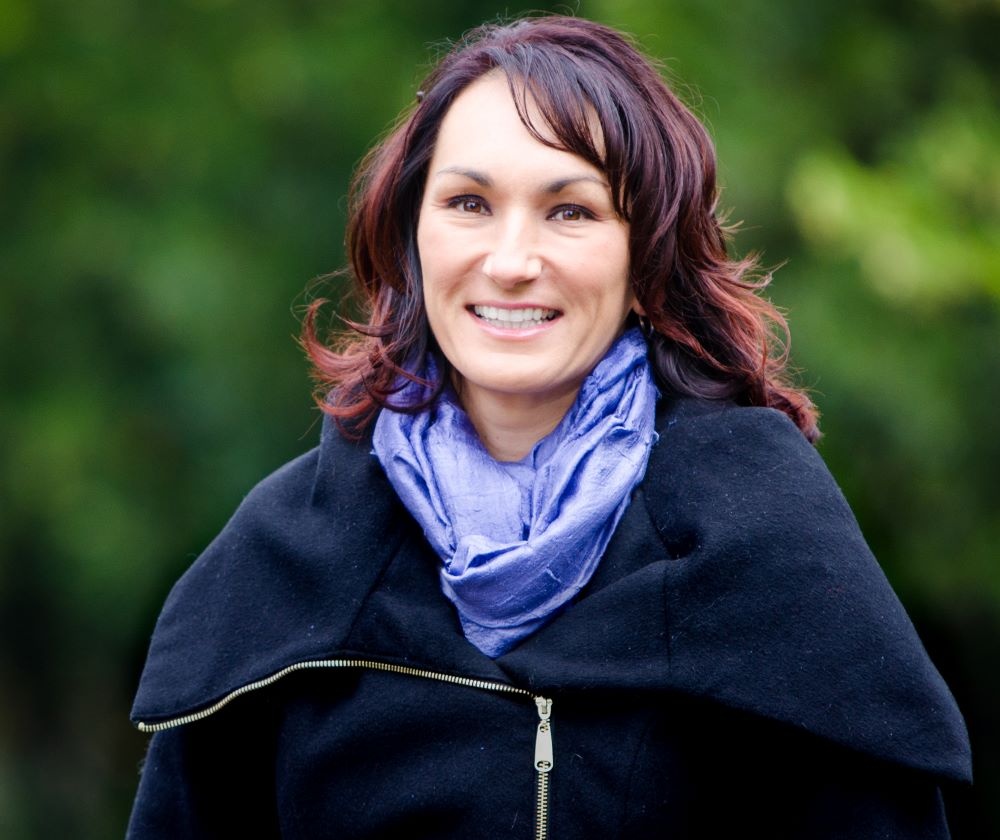
Dr. Puchalski is one of very few board-certified equine Radiologists in the country and one of the most high profile of those in the world. Early in her career, Dr. Puchalski earned the respect of the best in the industry and strives to continue to contribute advances for equine sports medicine and diagnostic imaging.
Dr. Puchalski’s job takes extensive training and a high level of specialization to properly review diagnostic imaging, including MRIs and Nuclear Scintigraphy bone scans to produce written reports for referring veterinarians. In addition to her full-time position with Palm Beach Equine Clinic, she reads cases from all over the world on a daily basis. Many veterinarians and owners request to consult with her for a second opinion.
Potential for Growth
After eight years working as a faculty member at the University of California Davis, Dr. Puchalski decided to take a job with Palm Beach Equine Clinic in December 2013. She had been consulting on Palm Beach Equine Clinic cases for several years prior to the move and felt it was a natural progression. Palm Beach Equine Clinic made huge advances to their in-house imaging technology under her direction.
Almost 30 years ago, Palm Beach Equine Clinic bought the first ultrasound for equine practice in South Florida. Twenty-five years ago, Palm Beach Equine Clinic installed the first gamma ray camera to perform bone scans (Nuclear Scintigraphy). Twenty years ago Palm Beach Equine Clinic developed Computed Radiography (CR) for horses. Currently, Palm Beach Equine Clinic has the most advanced state-of-the-art surgical and diagnostic imaging equipment available. Onsite, they have a Hallmarq standing equine MRI unit, MiE gamma ray camera, Digital Radiography, Video Endoscopy, and a bevy of additional diagnostic equipment.
“ Palm Beach Equine Clinic has a great case population and great equipment, which is a huge bonus for someone doing what I do,” Dr. Puchalski stated. “The equipment is exceptional, the technical staff is excellent, and the case population of the region is obviously amazing.”
Palm Beach Equine Clinic is dedicated to providing exceptional veterinary service for the horse, and Dr. Puchalski proudly supports that mission through her work. She diagnoses issues from complicated images that assist veterinarians in the proper, effective treatment plan. She is able to provide a second opinion on routine diagnostic techniques such as radiographs and ultrasounds. She is also able to provide diagnostic reports for pre-purchase examinations based on the imaging submitted.

For Dr. Puchalski, the potential for future growth in diagnostic imaging services at Palm Beach Equine Clinic is huge.
“There are new technologies coming into the market for imaging all of the time and Palm Beach Equine Clinic will remain abreast of those advances,” Dr. Puchalski said. “Going forward, we are looking to acquire new equipment, and I think it is fair to say that the hospital will see an increasing role with different kinds of cases. There are a lot of changes in the market that occur very quickly, so we are always trying to figure out the best thing for this practice.”
Finding Time to Ride
In addition to working with PBEC locally and assisting veterinarians around the world, Dr. Puchalski competes her Oldenburg mare, Lucia de Luxe, in the Medium and High Amateur-Owner Jumpers.

Dr. Puchalski splits her time throughout the year between her homes in California and Florida. She is based in Wellington for about five months, and enjoys competing at the Winter Equestrian Festival, for which PBEC serves as the official veterinarians.
Although her horse is currently injured, Dr. Puchalski normally rides every day and enjoys the flexibility of her job that supports her riding schedule.
“One of the best parts of what I do is the flexible schedule,” she admitted. “I try to ride every day and fit everything else around it. I can really do my job from anywhere. It can be completely web-based, which I love.”
“First thing in the morning, I check into the clinic and check on the imaging cases for the day,” Dr. Puchalski detailed. “I usually read some MRI and Nuclear Scintigraphy cases and then go ride mid-morning. Then I come back and read cases for my other clients. PBEC is a big chunk of my work, but a lot of my cases also come from global clients; I have clients all over the world.”
From a Small Town to Big Dreams
Dr. Puchalski grew up on a small-town acreage in British Columbia and started riding at a very young age. She got her first pony when she was four years old and continued riding at a three-day eventing barn next door to her home. Early on, Dr. Puchalski knew that she wanted to be a veterinarian. Dr. Puchalski graduated with a BS in Biology from Simon Fraser University in British Columbia, and completed her Doctorate of Veterinary Medicine from the University of Saskatchewan in Saskatoon. She interned in Field Service and Sports Medicine at New Bolton Center at the University of Pennsylvania, and completed her residency in Radiology at UC Davis in 2005.
During her internship at the New Bolton Center, Dr. Puchalski decided to pursue a career as a Radiologist thanks in part to one of her valued mentors, Virginia Reef, at the University of Pennsylvania.
“Dr. Reef was a huge influence on my career direction at that stage,” Dr. Puchalski noted. “Ginny was an influence in me becoming a radiologist, and then as a radiologist, I was mentored by Tim O’Brien at UC Davis – he is a founding father of equine radiology.”
Continuing to Have an Influence
Prior to joining PBEC in 2013, Dr. Puchalski spent eight years on the faculty of UC Davis providing research instruction and clinical service. Dr. Puchalski has published many scientific articles in diagnostic imaging and equine injuries which was a huge component of her early career.
“Once you have published research, the spinoff is then to publish in textbooks and other literature, so I have done a number of chapters for major lameness and diagnostic imaging textbooks as well,” Dr. Puchalski explained. “I have published more than 50 scientific articles and performed over 100 presentations all over the world on lameness diagnosis and diagnostic imaging in sport horses. I am currently trying really hard to still publish study results and be involved with universities, but also have a very busy private practice caseload.”
Outside of work and horses, Dr. Puchalski enjoys the challenges of Crossfit. In addition to her time spent in Florida and California, she also spends several weeks every summer working and showing at Spruce Meadows in Calgary, Alberta, Canada.
Dr. Puchalski is an integral part of the team at Palm Beach Equine Clinic and will continue to serve PBEC’s clientele as diagnostic imaging advances into the future.
Palm Beach Equine Clinic provides experience, knowledge, availability, and the very best care for the horses of Wellington. Have them be a part of your team! To find out more, please visit www.EquineClinic.com or call 561-793-1599. “Like” them on Facebook to follow along on what happens in Wellington and more, and get news from their Twitter!
More About Dr. Sarah Puchalski
Dr. Puchalski is a Diplomate of the American College of Veterinary Radiology whose specialty includes the interpretation of radiographs in addition to other diagnostic imaging techniques.
Dr. Puchalski is from Davis, CA, where she was an associate professor at the University of California in their Department of Surgical and Radiological Sciences. In 1995, she received her BSc in biology from Simon Fraser University in British Columbia, and in 1999 earned her Doctor of Veterinary Medicine from the University of Saskatchewan in Saskatoon, where she received the ACVS Outstanding Large Animal Surgery Student award that same year. Dr. Puchalski interned in Field Service and Sports Medicine at New Bolton Center at the University of Pennsylvania in 2001, and completed her residency in radiology at UC Davis in 2005.
Dr. Puchalski has devoted her career to teaching and improving equine health through the development and refinement of diagnostic techniques. In 2011 she contributed to two books on the topic of equine lameness. Her recent contributions include chapters in Diagnosis and Management of Lameness in the Horse edited by Ross and Dyson, as well as in Veterinary Computed Tomography and the Clinical Veterinary Advisor: The Horse, Equine Colic and Veterinary Clinics of North America. She also has contributed close to 50 scientific articles concerning the diagnosis of equine lameness to many periodic journals, including Veterinary Radiology & Ultrasound: the official journal of the American College of Veterinary Radiology and the International Veterinary Radiology Association; Veterinary Pathology; Equine Veterinary Journal; the American Journal of Veterinary Research; Equine Veterinary Education; Journal of the American Veterinary Medical Association; and Journal of Veterinary Internal Medicine.

Dr. Sarah Puchalski is a Diplomate of the American College of Veterinary Radiology whose specialty includes the interpretation of bone scans, MRI, ultrasound, radiographs and other diagnostic imaging techniques. With her addition to the staff, Palm Beach Equine Clinic is one of the few equine hospitals in the country to employ a full-time radiologist on-site. In addition to working with horses locally and assisting veterinarians around the world, Dr. Puchalski also competes in the Medium and High Amateur Owner Jumper circuits.
It is important for clients to get know our doctors so we asked Dr. Puchalski to share a little about herself!
How do you like being in Wellington and having the opportunity to compete at the Winter Equestrian Festival?
I think it is a really unbelievable opportunity to ride in the most competitive rings in the country regardless of the level at which you are competing.
How do you like working at Palm Beach Equine Clinic?
Palm Beach Equine Clinic is great place to work. It is very vibrant and busy. I like the energy that comes out of the place and the imaging equipment is world-class.

Why do you feel it is important to have a Board Certified Radiologist on site?
My full time job is image reviews which takes a high level of specialization. This provides support for all veterinarians ranging from field veterinarians to surgeons. It is very rare for an equine hospital to have a full-time radiologist so having one on board offers a step up in the quality of service. When a horse comes in for an MRI or bone scan everything can be reviewed before the horse leaves the clinic so if any other care is needed it can be handled in one visit.
What ways do veterinarians use radiologists?
There are a couple ways. One is that I read complicated images such as bone scans and MRIs. Most veterinarians do not have the training to read these images. The second way is to provide a second opinion on routine diagnostic techniques such as radiographs and ultrasounds. Clients and referral veterinarians will also use my opinion for pre-purchase examinations.
Tell us about your studies and how you’ve developed an international reputation?

I did two internships in field service and sports medicine at New Bolton Center Hospital at the University Of Pennsylvania School Of Veterinarian Medicine. Then, I spent four years at the University of California, Davis in imaging. For eight years I stayed there as faculty for doing research instruction and clinical service. I have published more than 50 scientific articles and performed over 100 presentations around the world on lameness diagnosis and Diagnostic Imaging in Sport Horses.
What would you like veterinarians and owners to know about you?
My philosophy is to support all veterinarians, whether it be a veterinarian from Palm Beach Equine Clinic or a referral. I read cases from all over the world on a daily basis. Many owners ask their veterinarian to consult with me for a second opinion. I view my role more as a support role for all veterinarians to provide the best care for horses.
Palm Beach Equine Clinic welcomes new veterinarian Radiologist, Dr. Sarah Puchalski, and Surgeon, Dr. Weston Davis. Dr. Puchalski is a Diplomate of the American College of Veterinary Radiology. Her specialty includes the interpretation of radiographs in addition to other diagnostic imaging techniques.
New Team Members
With Dr. Puchalski’s addition, Palm Beach Equine Clinic is pleased to be one of few practices in the country with a full-time board certified radiologist.
Dr. Davis is a Board Certified surgeon specializing in equine sports medicine. Dr. Davis joins Dr. Bob Brusie and Dr. Jorge Gomez at Palm Beach Equine Clinic providing exceptional surgical expertise in orthopedic and soft tissue related problems including emergency colic surgery.
Expanded Facilities
In addition to this exciting news comes the announcement of a new expansion to their veterinary hospital. PBEC is located less than one mile from the Winter Equestrian Festival and across the street from the Global Dressage Festival. The expansion includes a new barn containing 11 intensive care stalls capable of providing advanced medical treatment and post-operative care. The added stalls and office space makes Palm Beach Equine Clinic the most progressive, well-equipped facility in the region for equine veterinary care.
Palm Beach Equine Clinic (PBEC) is the one of the select few equine hospitals in the country with three board-certified surgeons. With 24 veterinarians on staff, they are the most complete hospital in the southeast United States, ready to handle any emergency as well as elective surgery and preventative care.
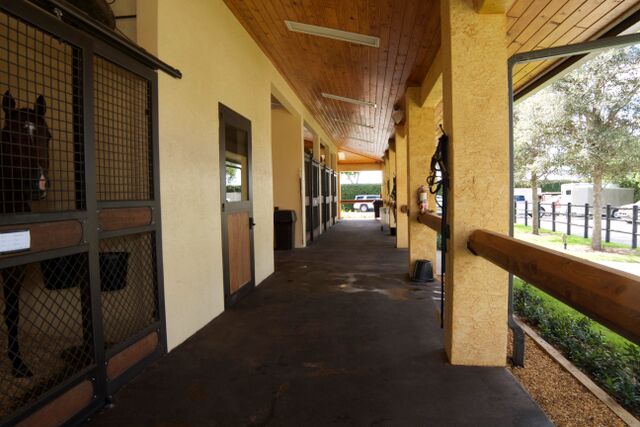
Exceptional Equine Medical Care
Palm Beach Equine Clinic has locations in Wellington, Florida, Long Island, New York and satellite veterinarians throughout the United States. PBEC provides exceptional equine medical care with an unwavering commitment to the horse for more than 30 years. Working with patients that range from the reliable amateur horse to Olympic athletes, PBEC’s mission from day one has been to provide innovative veterinary services that promote health and happiness in horses while extending their performance careers. With this mission in mind, Palm Beach Equine Clinic remains the leading service provider in equine veterinary medicine.
From December 1st, 2013 through April 1st, 2014, PBEC is pleased to offer tours by appointment. After scheduling an appointment, guests can look forward to a tour of the facility and time to talk with veterinarians. Tours will include the new hospital, Nuclear Scintigraphy room, and Surgery Center. Visitors will have an opportunity to ask questions and meet all the new doctors on staff. PBEC is located at 13125 Southfields Road in Wellington, Florida.
Contact PBEC for more information
Palm Beach Equine Clinic is respected throughout the industry. Well known for an unwavering commitment to the horse and their owners, PBEC offers innovative, advanced medical care. Known as leaders in new diagnostics and therapies, PBEC veterinarians have published numerous articles in equine magazines and journals.
